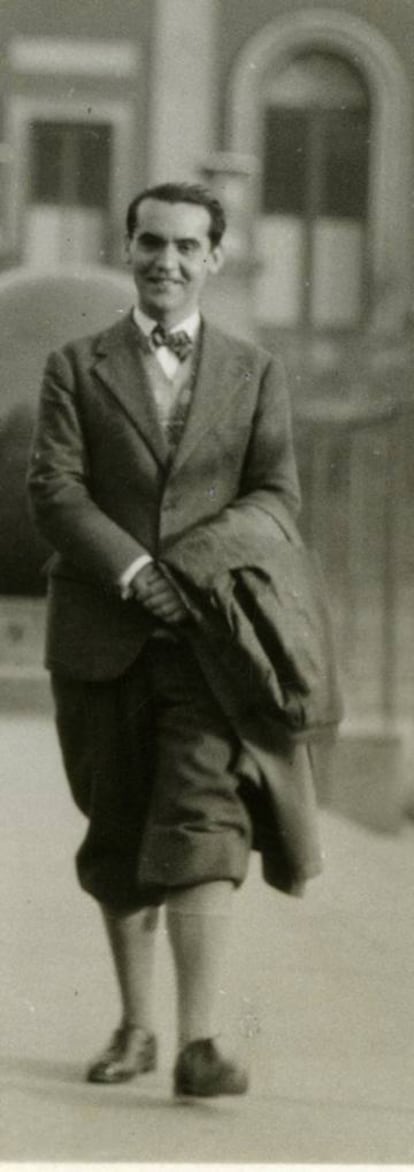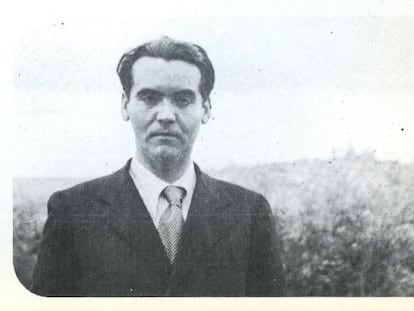Lorca’s legacy will stay in Spain
Rumors that part of his work could be sold off to repay the foundation’s debt drives government to action


Spanish authorities are seeking to ensure that the creative legacy of Federico García Lorca will stay in Spain.
Faced with the threat of seeing part of his work sold or divided up to pay off a debt estimated at €10 million by the Spanish Culture Ministry, the acting central government and Madrid regional officials have declared the writer’s entire oeuvre a Bien de Interés Cultural – BIC, or Cultural Asset.
This legal status aims to afford protection from the mismanagement detected at the foundation that is in charge of preserving his legacy, the Fundación García Lorca.
In just one week, state secretary for culture José María Lassalle and the regional administration, headed by Popular Party politician Cristina Cifuentes, have decided to step in and prevent the potential dispersal of Lorca’s work by foundation managers desperate to raise cash.
The decision was first relayed to the Lorca family and to the foundation trustees, in what constitutes another dramatic chapter in a story that began in June 2015. It was then that Laura García Lorca, the poet’s niece and head of the foundation, filed a complaint against her financial officer, Juan Tomás Martín, accusing him of misappropriating funds and forging documents.
There was a project underway to build a brand new García Lorca Center in Granada, his home province, to house a legacy that currently sits inside the Residencia de Estudiantes in Madrid, where Lorca was once a resident student. The new facilities were scheduled to open on June 5.
But construction company Ferrovial claimed €3 million in late payments from the consortium in charge of the project, which is made up of the Culture Ministry, the Andalusian government, the city of Granada and the provincial authority, besides the foundation itself.
Later came a chain of defaults and unpaid bills, and questions regarding the final destination of a generous gift of €4 million that the government of Norway had made toward the project.
International funds
Besides the funds granted by various Spanish administrations for the construction of the Federico García Lorca Center, there are international gifts that were apparently unaffected by the alleged financial mismanagement, yet may have been damaged in terms of the project’s reputation.
Norway, Liechtenstein and Iceland donated €4.8 million to pay for building equipment and programming expenses. This money was managed directly by the consortium, not by the foundation, and remains untouched by the scandal.
But ministry sources said that Norwegian authorities have expressed great concern over the situation and asked for a quick resolution to the problem. Part of the reason why national and regional authorities in Spain want to act fast is to prevent any damage to the poet’s – or the country’s – international reputation.
The recent arrest of the mayor of Granada in a real estate corruption raid, a fact that did little to allay investor fears, was another determining factor in the decision to move fast.
Of the €27 million that the foundation manager handled throughout the years, €4.4 million remain unaccounted for, according to the consortium governing council’s calculations.
Ever since the problem surfaced, there has been a flurry of negotiations between foundation trustees, government representatives and the companies involved in order to find a “good faith” solution, said Culture Ministry sources.
But suggestions by some of the parties to the effect that part of Lorca’s legacy could be sold off to repay debt set alarm bells ringing at government levels.
The Culture Ministry has taken the first step, but Spanish law mandates that it is the government of the region where the legacy is kept who must execute the specific measures that will preserve it from division. While this role currently falls to the Madrid region, authorities in Granada have also been informed, as that is the final destination of the work of the author of Poet in New York and Blood Wedding.
“Federico García Lorca, [Luis] Buñuel, (Salvador) Dalí and [Pablo] Picasso are fundamental names in 20th-century Spanish culture. We cannot allow this legacy to escape us, much less put it at risk,” said Lassalle.
Anunciada Fernández de Córdova, head of the Madrid Office of Culture and Tourism, said that a comprehensive inventory of Lorca’s legacy is being drawn up. This newspaper was unable to reach the poet’s family for comment.
The García Lorca Foundation was created in 1982, and has been housed within the Residencia de Estudiantes since 1986. Madrid regional premier Cristina Cifuentes said that by declaring this archive a BIC, “it goes from the basic protection level enjoyed by the documents to date to the very top protection level.”
Thousands of items
The collection contains 46 original drawings by Lorca, 2,343 handwritten pages with prose, plays and poetry, a significant photo archive with more than 900 inventoried images, musical material including pieces written by Lorca himself, and 300 more musical pieces that he collected.
Lorca’s personal library is also part of this legacy. It contains an important collection of literary magazines from his era, around 125 books with personal dedications by their authors, another 4,624 catalogued books and over 500 still pending registration; and the author’s correspondence, which comprises 176 letters to his family and over 2,000 pages of letters addressed to him. The fund also has copies of all the editions ever printed of Lorca’s work in Spanish and in several translations.
Lorca also collected art, and owned work by Salvador Dalí, Ramón Gaya, Ismael de la Serna, Rafael Barradas, Manuel Ángeles Ortiz, José Caballero and Benjamín Palencia, among others. Other items in the collection include thousands of press clippings from Spanish and foreign newspapers, and a significant number of books and articles about his life and work. The Lorca legacy totals more than 19,000 items.
English version by Susana Urra.
Tu suscripción se está usando en otro dispositivo
¿Quieres añadir otro usuario a tu suscripción?
Si continúas leyendo en este dispositivo, no se podrá leer en el otro.
FlechaTu suscripción se está usando en otro dispositivo y solo puedes acceder a EL PAÍS desde un dispositivo a la vez.
Si quieres compartir tu cuenta, cambia tu suscripción a la modalidad Premium, así podrás añadir otro usuario. Cada uno accederá con su propia cuenta de email, lo que os permitirá personalizar vuestra experiencia en EL PAÍS.
¿Tienes una suscripción de empresa? Accede aquí para contratar más cuentas.
En el caso de no saber quién está usando tu cuenta, te recomendamos cambiar tu contraseña aquí.
Si decides continuar compartiendo tu cuenta, este mensaje se mostrará en tu dispositivo y en el de la otra persona que está usando tu cuenta de forma indefinida, afectando a tu experiencia de lectura. Puedes consultar aquí los términos y condiciones de la suscripción digital.
More information
Últimas noticias
Maduro pleads not guilty before the federal court in New York: ‘I am still the president of Venezuela’
A new test can detect Alzheimer’s from a finger prick
UN team enters Sudanese city of El Fasher after paramilitary massacre: ‘It’s like a ghost town’
A recipe for resistance: Indigenous peoples politicize their struggles from the kitchen
Most viewed
- Gilles Lipovetsky: ‘If you want to live better and fall in love, take Prozac, don’t look to philosophy’
- Alain Aspect, Nobel laureate in physics: ‘Einstein was so smart that he would have had to recognize quantum entanglement’
- Maduro’s downfall puts China’s relationship with Venezuela to the test
- Why oil has been at the center of Venezuela-US conflicts for decades
- Alvin Hellerstein, a 92-year-old judge appointed by Bill Clinton, to preside over Maduro’s trial in New York










































